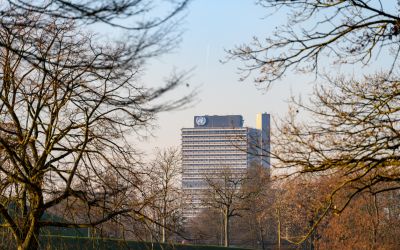Noor Elshatlawy on GHD’s role in driving change in the hydrogen sector
Ahead of COP28, Climate Action caught up with Noor Elshatlawy, Future Energy and Origination Advisor at GHD, to discuss GHD’s role in driving change in the hydrogen sector.

Ahead of COP28, Climate Action caught up with Noor Elshatlawy, Future Energy and Origination Advisor at GHD, to discuss GHD’s role in driving change in the hydrogen sector.
1) Can you tell us a bit more about the UAE Hydrogen Strategy and the COP28 Hydrogen Change Maker Initiative you are currently working on?
The Hydrogen Strategy charts a course for the United Arab Emirates to become a premier global producer of low-carbon hydrogen by 2031. Execution of the strategy will help the UAE to achieve net zero by 2050, solidifying the nation's position as a leader in the global energy market.
In addition to working on the UAE Hydrogen Strategy, I was also selected by the COP28 Energy team to be a member of the Hydrogen Expert Committee as part of the Energy Transition Changemakers Initiatives. In this role, I joined a panel assessing 200 hydrogen project submissions and the top 10 winning projects will be announced during the Conference.
Overall, it has been incredibly gratifying to be a part of these two efforts which demonstrate the UAE's commitment to furthering global sustainability initiatives. While the strategy is fundamental to meaningful progress in the UAE, I believe the Hydrogen Expert Committee is demonstrative of our nation's commitment to making this strategy real.
2) The UAE Hydrogen Strategy aims to position the country as a global low-carbon hydrogen producer by 2031, what key milestones or accomplishments can you highlight in laying the groundwork for this ambitious vision? How does it differ from other hydrogen strategies?
The strategy outlines robust policy frameworks and provides a solid regulatory foundation for industry growth. This includes the creation of hydrogen oases (otherwise known as hydrogen hubs), which are locations that have been identified as focal points for accelerating domestic hydrogen growth and ensuring immediate environmental benefits. In addition to this, the strategy plans to leverage the UAE’s abundant natural gas resources and advanced carbon capture, utilisation, and storage (CCUS) capabilities, enabling our nation to play a central role in the development and deployment of low-carbon hydrogen technologies.
Collaboration is a central pillar to the strategy – the UAE is actively engaging European and Asian markets to establish a thriving regional hydrogen market. This collaborative effort will enhance energy security and promote a unified approach to addressing global sustainability challenges. Investment in Research and Development (R&D) is another key pillar of this ambitious vision, positioning the UAE at the forefront of technological innovation. A commitment to R&D will ensure the continuous improvement, and adaptability, of ever-evolving global energy landscapes.
Overall, the UAE National Hydrogen Strategy's multifaceted approach encompasses domestic decarbonization, global collaboration, policy development, and cutting-edge R&D, to position the UAE as a key player in shaping the future of the global hydrogen economy.
3) How will the COP28 Hydrogen Change Maker Initiative accelerate progress?
The COP28 Hydrogen Change Maker Initiative strategically employs innovation as a catalyst for progress. By amplifying successful hydrogen project examples from around the world, the initiative will help to propel the world towards a more sustainable and decarbonized energy landscape.
On December 5, the Committee will announce our top 10 projects in the Green Zone at COP28. Out of the 200 projects we analysed, these are the projects exemplifying how to overcome difficult challenges and utilise groundbreaking innovations to demonstrate what is achievable. Our strategic judging criteria for assessing projects is based on the key principals of innovation, scalability, project progress, collaboration, a just transition and tangible solutions.
This broad criterion ensures that what is considered ‘innovative’ is not confined to isolated successes but can be replicated and adopted on a broader scale. Incorporating a just transition into the criteria was also critical, ensuring that winning solutions demonstrate tangible emissions reduction and address socioeconomic factors to foster equitable distribution of benefits across society. By seeking projects on a global scale, we are also facilitating the exchange of innovative ideas and practices across borders.
4) What have you personally learned working on these initiatives?
In my role contributing to both the hydrogen strategy and the Change Maker Initiative, I've gained invaluable insights into the intricate world of sustainable energy initiatives. These two strategies are interconnected in nature. Together, they demonstrate the importance of local and international collaboration for comprehensive sustainability objectives.
Both experiences have evolved my understanding of innovation. To me, tangible innovative solutions are those that merge engineering with a broader social context to bring theory and scientific solutions to life. The dynamic nature of the energy landscape demands flexibility and adaptability. Learning from both the strategy and the initiative, I've come to appreciate the importance of staying agile in the face of evolving technologies, global dynamics, and emerging challenges.
Working with the Change Maker Initiative has underscored the pivotal role of innovation in driving change. Witnessing the impact of groundbreaking projects on the global stage has reinforced the idea that innovation is not just desirable, but a necessary catalyst for accelerating progress in the energy sector. Engaging with the Change Maker Initiative has also broadened my perspective on global sustainability challenges. Our focus on projects with a global impact has reinforced the idea that addressing complex issues requires a collaborative, worldwide effort, transcending geographic boundaries. It's only through a multidimensional approach, involving governments, businesses, and communities, that we can achieve successful, sustainable outcomes which achieve long-term benefit for society.
Overall, this dual involvement has deepened my understanding of the complexities and opportunities in the sustainable energy landscape. It has reinforced the idea that successful strategies require visionary planning, innovation, collaboration, and a continuous commitment to adaptability and learning.






